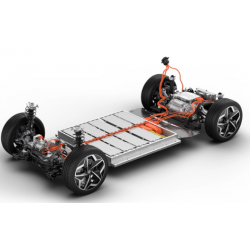How to understand the nominal capacity, total capacity and net capacity of electric vehicle batteries?

How to understand the nominal capacity, total capacity and net capacity of electric vehicle batteries?
Simply put, battery capacity is the energy contained in an electric vehicle’s battery pack. It's just as important as motor power and torque because a car's range depends on the size of the battery and how efficiently the car uses that energy.
Energy capacity is measured in kilowatt hours, or the battery's ability to provide a set power output (measured in kilowatts) for a period of time (measured in hours). Even on the highway, most vehicles only require 20 to 30 kilowatts of power to maintain a steady speed. So, depending on the vehicle, a 60 kWh battery can support up to three hours of driving. Factors such as speed and external temperature can also significantly affect battery usage.

The range of an electric vehicle depends on the size of the battery. There are two measures of battery capacity, and manufacturers are not always clear about what their stated capacity represents.
Total capacity (or total capacity) is the total energy that a battery pack can theoretically hold.
Net capacity (or usable capacity) is the amount of energy the car can utilize while actually driving.
Nominal capacity refers to the amount of energy an electric vehicle battery can store and subsequently release under optimal conditions. It's a fundamental indicator of battery performance, giving you insight into an electric vehicle's range, efficiency, and overall capabilities. Nominal capacity is expressed in ampere hours (Ah) or kilowatt hours (kWh).
Ampere Hours (Ah): Ampere hours represent the amount of power an electric vehicle battery can provide over time. One amp hour is equivalent to delivering one amp of current for one hour. For example, if the battery has a nominal capacity of 100Ah, it can provide 100 amps of continuous current for one hour, 50 amps of continuous current for two hours, and so on.
Capacity (Q) = Current (I) x Time (Hours)
Kilowatt hour (kWh): It is the product of voltage and current for a specific duration. A battery with a nominal capacity of 50 kWh can provide 50,000 watts (or 50 kilowatts) of power for one hour, 25 kilowatts for two hours, and so on.
Energy (kWh) = Power (kW) x Time (hours)
This difference is necessary because completely draining a battery of its last electrons could damage the battery or shorten its life. Automakers set aside a margin to prevent the battery from being fully discharged and charged to 100% capacity. These margins are only a few percentage points, but significant.
Confusion can arise when manufacturers quote battery capacity without specifying whether it is gross or net capacity. You want to know the net capacity because this is the energy available to the driver. We quote net capacity only, and if the automaker doesn't provide an exact number, our editors use standard factors to estimate a car's net battery energy.
Case in point: the Porsche Taycan, the brand’s first electric car. The company initially only quoted a total battery capacity of 93.4 kWh for the smaller of the two available battery packs, and later quoted 79.2 kWh. However, repeated questions from journalists convinced Porsche that available capacities were also available: 83.7 kWh and 71.0 kWh. These lower capacity figures explain some of the early disappointment with the Taycan's relatively modest range figures, although it performed much better in real-world testing.
In each case, Porsche reserves around 10% of the total capacity to prevent complete discharge or overcharging. This appears to be similar to other brands, although automakers are often extremely reluctant to provide details.
Available capacity generally corresponds to the state of charge (0-100%) indicated by the car as seen by the driver. While different automakers have different strategies for low-end cushioning, some offer extra mileage even after you hit the indicated 0 percent. The last thing before running aground is usually "snail mode," a few miles of slow, low-speed travel.
However, even though the portion of your battery's capacity that can be used for propulsion is limited, many automakers recommend that you not regularly charge more than 80 to 90 percent of the indicated charge. This helps extend the life of the battery and prevents its capacity from decreasing over time.
As usual, Tesla is doing things a little differently. It specifies the battery capacity first; the first few years of Model S production offered 60, 85, and 100 kWh battery packs at various points. A few years ago, with the advent of the Model 3, it changed strategy.
The meaning of nominal capacity
Driving range: The nominal capacity directly affects the driving range of electric vehicles. Higher capacity batteries can store more energy, allowing the vehicle to travel further distances on a single charge.
Charging time: Battery capacity also affects how long it takes to fully charge. Larger capacity batteries take longer to charge, especially when using a standard household outlet. However, advances in fast charging technology are closing the gap.
Performance: A battery's ability to provide consistent power output and maintain performance is closely related to its capacity. Higher capacity batteries provide more energy to accelerate and maintain high speeds.
Total Cost of Ownership: The nominal capacity of the battery affects the total cost of owning an electric vehicle. Higher capacity batteries generally cost more but may offer better long-term value in terms of range and resale value.
Factors affecting nominal capacity
Battery chemistries: Different battery chemistries, such as lithium-ion, nickel-metal hydride, and solid-state batteries, exhibit different energy densities and capacities. Lithium-ion batteries are currently the most common choice for electric vehicles due to their high energy density and relatively light weight.
Temperature: Battery performance is affected by temperature. Extreme cold or heat can affect battery efficiency and capacity. Most manufacturers provide an operating temperature range within which the battery will provide optimal performance.
State of Charge (SOC): State of charge indicates the amount of energy stored in the battery compared to its maximum capacity, affecting available energy. Operating a battery at extremely high or low SOC levels affects its service life and efficiency.
Cycling and Aging: Repeated charge and discharge cycles cause a battery to age, causing its nominal capacity to gradually decrease over time. A battery management system is used to optimize cycling and extend battery life.
edit author:
 Jinftry(Hong Kong registered company name: JING FU CAI (HONGKONG) INTERNATIONAL CO., LIMITED) is an electronic parts distributor selling latest electronic components including integrated circuits, IC electronics, IC integrated circuits, IGBT, IGBT modules, button battery LR44,discrete te semiconductors, circuit protection, capacitors, resistors, potentiometers, transformers, isolators, crystals , oscillators, resonators, power managers, connectors, switches, relays, sensors, optoelectronic devices, diodes, and various batteries. Welcome to purchase electronic components from brand manufacturers. To view the solutions, you can log in to https://www.jinftry.com/ for inquiries
Jinftry(Hong Kong registered company name: JING FU CAI (HONGKONG) INTERNATIONAL CO., LIMITED) is an electronic parts distributor selling latest electronic components including integrated circuits, IC electronics, IC integrated circuits, IGBT, IGBT modules, button battery LR44,discrete te semiconductors, circuit protection, capacitors, resistors, potentiometers, transformers, isolators, crystals , oscillators, resonators, power managers, connectors, switches, relays, sensors, optoelectronic devices, diodes, and various batteries. Welcome to purchase electronic components from brand manufacturers. To view the solutions, you can log in to https://www.jinftry.com/ for inquiries







